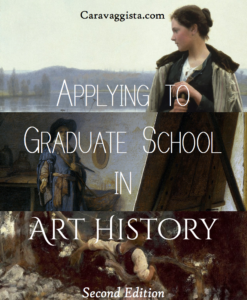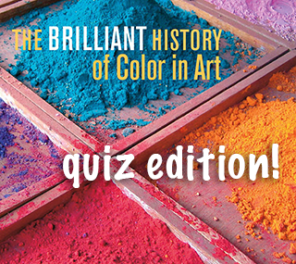
Amy Martin during a visit to the Getty
Meet Amy Martin. She’s an art historian, blogger, and open-access advocate who blogs on the popular Caravaggista tumblr, and recently launched arthistory.us, an open-access online journal.
On Amy’s latest visit to the Getty, I profiled her for #GettyInspired and asked what inspires her. Are art historians really afraid of the Internet? Can transparency and openness transform the field of art history and scholarship? And what’s the connection between the Baroque and public executions? (Yes, we went there.)
How did you find yourself at the intersection of art history and the Internet?
I was working in an architecture firm right out of college, and I felt I was in a bit of a stranglehold. I had no outlet for art history, which I had just spent four years studying.
I had the idea to make guides for art history students, to help them navigate art history classes and applications to graduate school, because at the time there were no resources, and my blog had turned into a “Dear Abby” thing where I was getting more questions in my inbox than I could keep up with. I thought if I wrote something out, people would just be able to download it and have the answers in one place.

Amy’s Guide for new art history students. Download the PDF.
Your blog is really generous. What inspires you to give so much of your time?
I feel like people need help. That was something I didn’t have when I was an undergraduate. I can think of three professors by name who really, really helped guide me and support me in the terrifying process of grad school and beyond, and who encouraged me when I felt that I wouldn’t be able to succeed.
I feel like there’s not enough of that, especially in academia. I do what I can to be that bridge now. I spend a lot of time thinking about what people send me, so sometimes it takes me a couple of months to reply, but I hope that by the time I’ve thought through their situation, they have tangible steps they could take to actually do what they want to.
Do you think art historians are scared of the Internet?
It’s a brave new world, coming from a discipline based on the monograph and the publish-or-perish model. When anybody can publish anything, it’s a threat to the way things have long been done.
I don’t think we’re going to be paying $500 to go to academic conferences and hear each other’s work anymore. I think we’re going to be live-streaming and opening things up for free, which is how we should be dealing with knowledge.

Amy’s Guide for Grad School students. Download the PDF.
What would you say to a scholar who is nervous to jump into digital publishing?
I would say to them what I tell myself, which is to just do it. Just release your work and realize that you’ll reach a broader audience. If you hold onto it and wait for that academic opportunity to publish it in an academic, peer-reviewed journal, then you’re really limiting your audience to a very select few people. I think it’s something that scholars need to take into consideration before they publish somewhere with a paywall or a subscription.
We’re getting into an age where people are wanting to educate themselves more, and do self-guided courses and read in their spare time, but they might be afraid of an academic journal or anthology. If scholars can ride this line between the Internet and legitimacy, between what’s possible now and the way academic publishing has always been, then maybe they can arrive at a happy medium for sharing work while still being recognized as experts.
In the introduction to his book about Renaissance art, Rudolf Preimesberger says that he wouldn’t write the same things today that he wrote ten years ago, and that he sees room for improvement in his own work. I think that that’s definitely something that scholars are always hesitant to candidly admit and why they hold onto their work—it’s never perfect enough until it is.
One of the reasons I love the Getty so much is because the Getty is not afraid of the Internet; they recognize the power of the Internet to draw people to art.
What’s been the most exciting part of your career thus far?
It’s always hard to say, because I know for me I’m always thinking about what’s next. I’d probably say working on my master’s thesis, which is about public executions on the Ponte Sant’Angelo in the 17th century.
Whenever I tell former professors, or just people, that that’s what I wrote my thesis on, their question is, “How did you get into such a strange field of study?” I went into grad school thinking I would be a Caravaggio specialist, that I would write papers about Caravaggio, and it just didn’t happen. I found this other field that I was interested in.
Amy Martin, inspired by execution. What about 17th-century executions drew you in?
I’ve always had a fascination with death. I grew up, probably like most children, reading books in school about the Holocaust and terrible tragedies. Then when I found out that there were these things called public executions, I was drawn to find out more.
Public executions were performances that involved the spectators of the city, the executioner, the prisoner, and the city itself, the urban fabric of the city. I think, what would it have been like to be in Rome in the 1600s and go to the bridge with Bernini’s statues and see this terrible criminal get executed? You’d watch this performance where the people orchestrating the execution are basically responsible for saving his soul. The angels are on the bridge to send a message about the man’s—about everyone’s—eternal fate. You’d never see the Ponte Sant’Angelo and those artworks the same again.

Contemporary view of the Ponte Sant’Angelo, Rome. Source: Flickr user Giuseppe Milo, CC BY-NC 2.0
How did you find the 1600s? How did you decide that this time period was for you?
I discovered Caravaggio in AP art history, but it really stuck in my brain that I wanted to study Neoclassicism. When I got to college, the neo-classicist professor passed away, and so I let that dream go. I went to the closest stylistic counterpart, which was the Baroque. It just fit. I loved the emotion and drama and intensity of Baroque art.
The way you describe the Baroque reminds me of the way you talk about public executions.
Ha! That’s interesting that you say that, because in the public executions, there was a need for drama and for the public to actually see the execution take place. Today, if we watch people wrestling or boxing and someone gets hit, we’re like, “Oh no!”—but we keep watching. It’s the same idea when the execution takes place: There’s all this anticipation on the part of the public that’s echoed, I think, in the style of art.
There’s that same heightened anticipation when you look at certain kinds of paintings and sculptures; it’s like you’re there and witnessing what’s happening. Like Caravaggio’s Martyrdom of Saint Matthew—you’re waiting for the executioner to bring down that sword and kill Matthew. I think there is that kind of cultural, artistic parallel with regard to drama and emotion.

Amy with her favorite paintings at the Getty
You’ve mentioned that you have a favorite room here at the Getty Center.
Yes! I love the room [Gallery E201] with the Gerrit van Honthorst’s Christ Crowned with Thorns, which hangs near Valentin de Boulogne’s Christ and the Adulteress. I love that they are near each other because they send a really interesting message about Christianity in the 17th century. They are almost two bookends on the narrative of Jesus’s life and mission. I guess I just love the 17th century.
To follow more of Amy’s work, check out her website + blog or Twitter, or submit to her open-access journal.
Text of this post © J. Paul Getty Trust. All rights reserved.

See all posts in this series »




Excellent read Sarah. Amy is great council; very AH – humanities gifted.
Thank you for reading, Elizabeth!